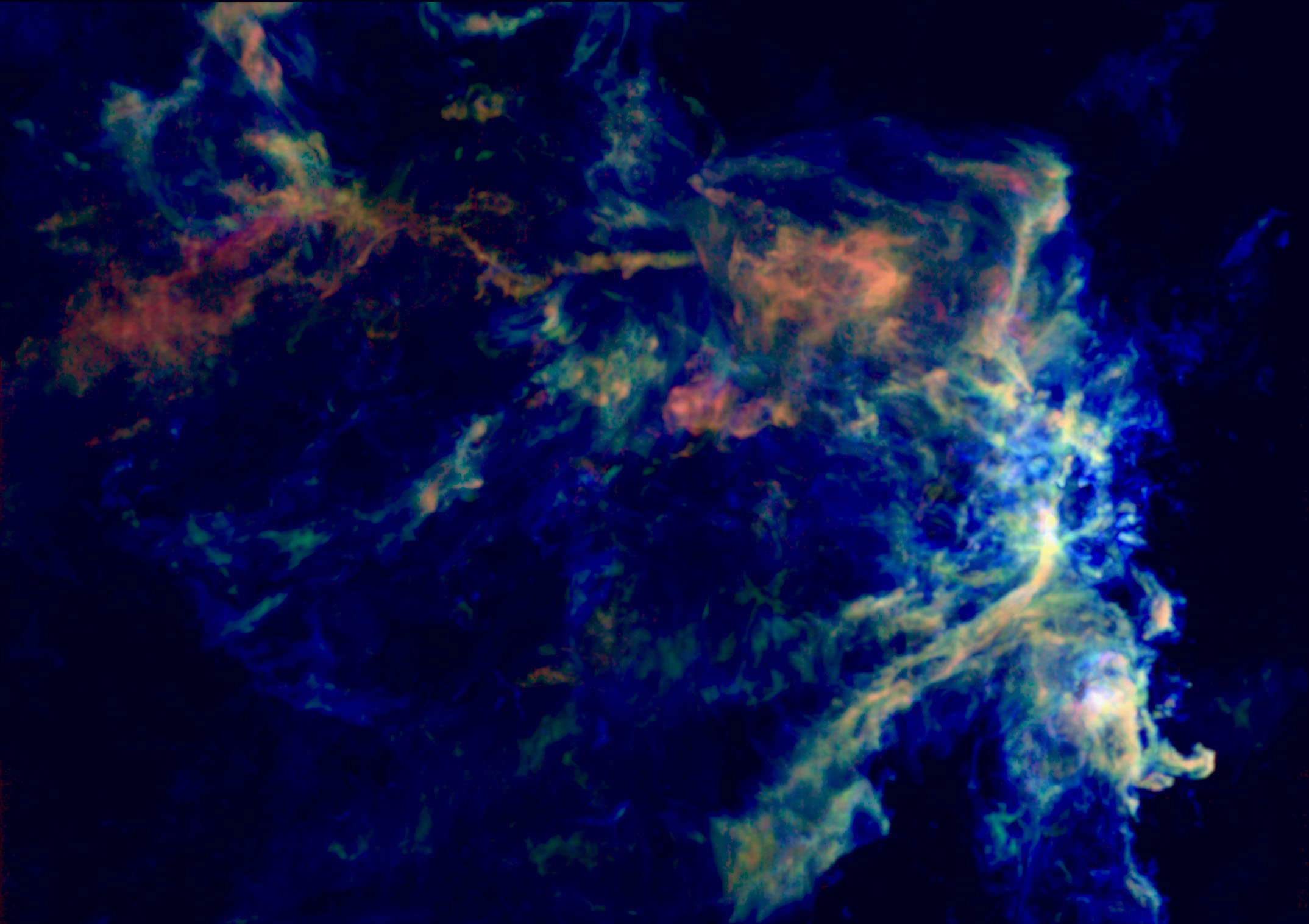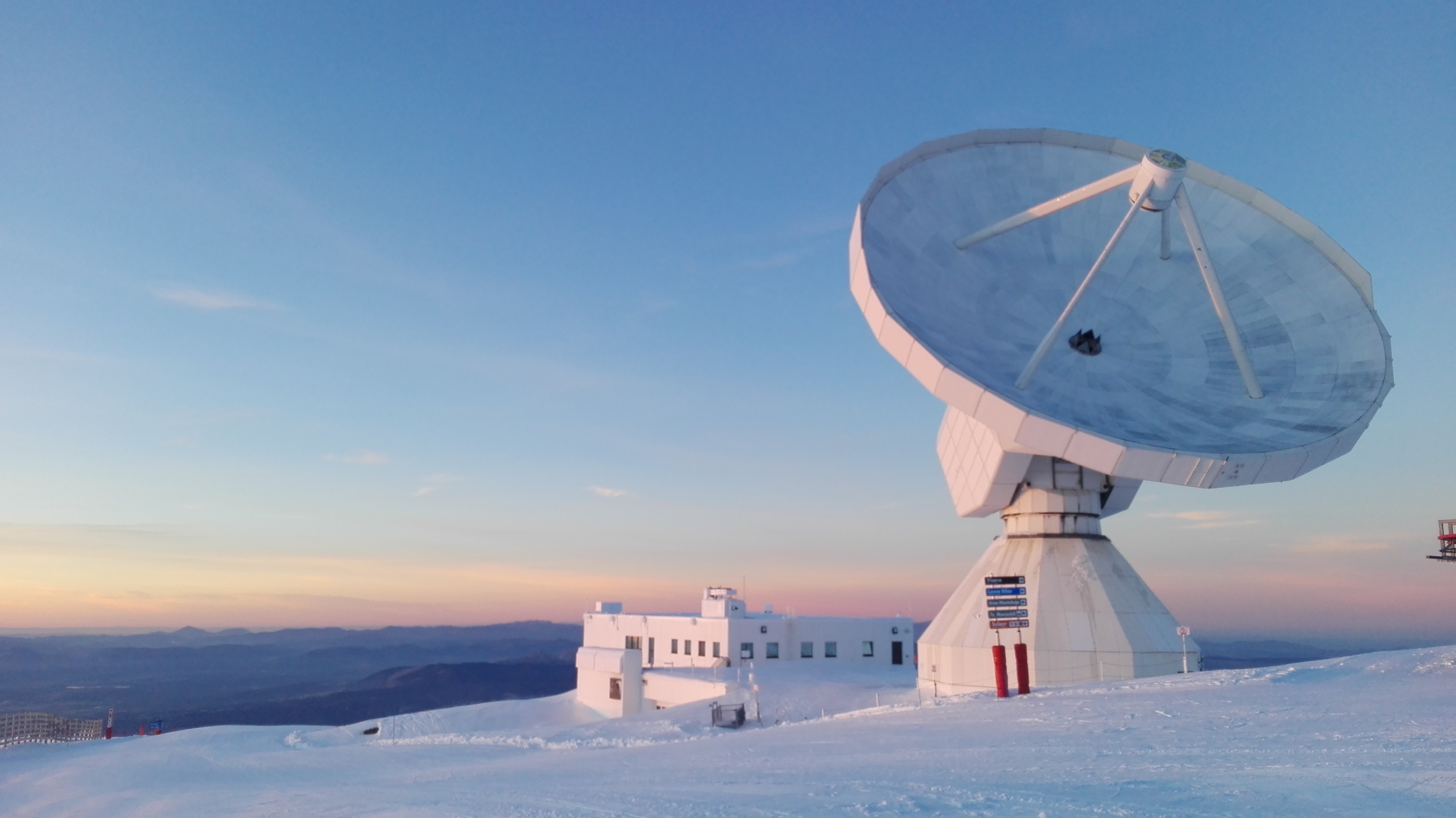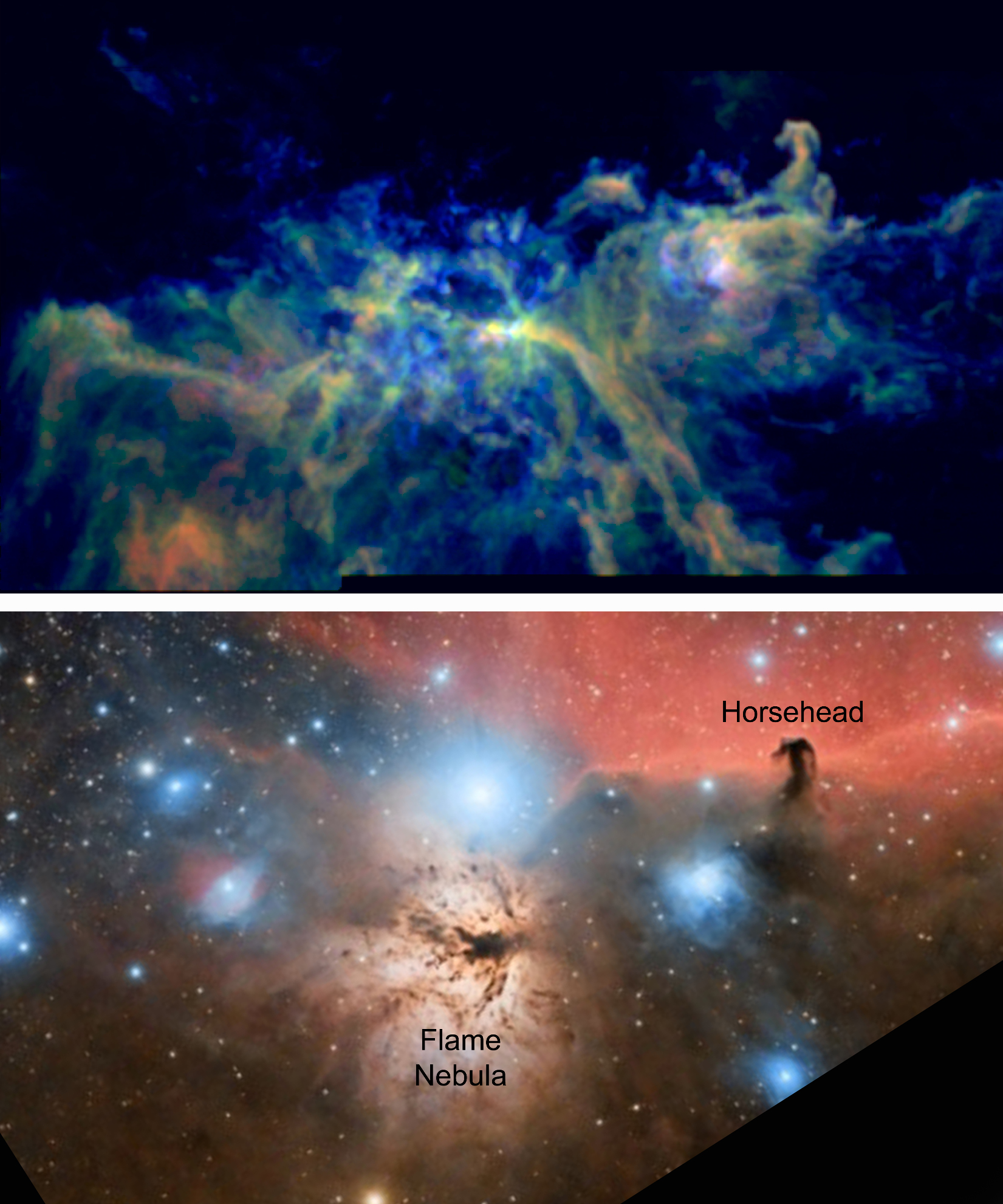Press releases
Artificial intelligence, a game-changer for studying stellar nurseries
2020-11-19
Star formation is a complex riddle because molecular hydrogen, the material that forms stars, cannot be directly detected at the low temperatures that prevail in the molecular interstellar medium. Radio-astronomers and signal and image processing experts have recently joined forces to develop new techniques that shed light into this long-standing astrophysical problem. By applying a new pluri-disciplinary approach to a state-of-the art mapping survey of 20 molecules in the famous Orion molecular cloud with the IRAM 30m telescope, the ORION-B team have mapped the star-forming material in the Orion Nebula with unprecedented precision, and revealed other hidden physical parameters that control the formation of stars. Their results have been published on November 19th, 2020 in Astronomy & Astrophysics
For more than half a century, astronomers have attempted to decipher the physical processes that control the formation of stars. Stars are born in molecular clouds that — as their name suggests — are primarily composed of molecular hydrogen gas. But at the very low temperatures typical of molecular clouds (-250°C), molecular hydrogen cannot be detected. Jérôme Pety, researcher at the Institut de Radioastronomie Millimétrique comments: “It's a bit like the water in an aquarium. We know it is there in large quantities and that it is important for the fish. But we don't see it. It is transparent. When we want to study currents, we have to add a dye in very small quantities and mix it with the water. It is said that the dye traces the movements of the water.” While molecular hydrogen at low temperature cannot be detected, molecular clouds contain other tracers, such as dust (1% of the mass) and other molecules present in minuscule amounts. The most commonly used tracer is carbon monoxide (CO). However, its concentration is about one molecule per 10,000 hydrogen molecules and its mixing with hydrogen is imperfect. CO therefore only provides a first estimate of the amount of gas present in molecular clouds.

- Fig. 1:
-
Carbon monoxide emission in the Orion B giant molecular cloud as observed with the 30-meter telescope. Credits: J. Pety, the ORION-B Collaboration, IRAM.
The idea of combining CO with other observable tracer molecules to obtain a more accurate estimate of the amount of molecular hydrogen has been proposed before, but previous efforts were defeated by the complexity of the physical and chemical processes that link the different molecules together. The secret of success turns out to be a totally new approach, combining analysis methods from artificial intelligence and the ingenuity of IRAM instrumentation that allows the 30m telescope to map a few tens of molecules simultaneously over fields of view covering 25 times the moon area. Laboratoire d'Astrophysique de Bordeaux researcher Pierre Gratier says: "We have shown that a machine learning algorithm called "random forests" can reveal the relationship that binds the different observable molecules to the total quantity of gas. It is thus possible to build a reliable and precise estimator for the quantity of molecular hydrogen using the emission of a reduced set (between 5 and 10) of different tracer molecules". Indeed, the precision increased by more than a factor 10, i.e., error on this quantity is reduced from 300% to 20%.
Accurately determining the amount of molecular hydrogen gas available to form stars is only the very first step for these studies. While molecular clouds are mostly neutral, the existence of free electrons in the gas is crucial to the molecular cloud’s evolution. Due to the presence of free electrons, the gas becomes sensitive to the presence of the cloud's global magnetic field, which channels the gas motions during the gravitational collapse that ultimately leads to star formation. These electrons are extremely rare — there is only one electron per 10 million hydrogen molecules — and the electron fraction of a molecular cloud cannot be measured directly. To overcome this challenge, the team used complex astrophysical models to explore thousands of different possible scenarios, each scenario producing thousands of potentially observable quantities. Emeric Bron, a researcher at the Paris Observatory, then applied a machine learning approach to the massive dataset of model results, allowing him to identify the observational tracers that encode precious information on the electron fraction. The new tracers revealed by this work will allow astronomers to estimate the electron fractions in more than 60% of a GMC like Orion B. In comparison, the traditional tracers used so far could only be observed in around 2% of such a cloud (only in the very densest regions of the cloud).
Once a theoretical relationship between an observation and a key physical parameter is revealed, astronomers face an additional challenge when applying it to actual data. The astronomical signals are quite faint. When trying to interpret these data using physical models, the noise often blurs the conclusions. In a third study, Antoine Roueff from Institut Fresnel uses information theory to precisely separate the physics from the artifacts caused by noise. This is essential because it allows researchers to know if they need to keep working to extract more information or if the data is too noisy to answer the question being asked.

- Fig. 2:
-
The IRAM 30-meter telescope in the Spanish Sierra Nevada. Credits: IRAM.
These three studies illustrate how closer links between astrophysicists and experts in signal processing and machine learning can lead to new powerful tools to study the birthplace of stars. Jérôme Pety comments: "As well as being essentially invisible, the places where stars are born are complex systems. Faced with a system of such complexity, subject to the vagaries of its environment and history, a complete causal and deterministic understanding is not possible. We must now seek to understand the evolution of molecular clouds towards the formation of new stars and their planets using statistical laws. Our project has precisely the enormous amount of data needed to identify these statistical laws, but it thus also requires going beyond classical data analysis methods in astronomy.”
Pierre Chainais, professor at CRIStAL laboratory, adds: "Astrophysical problems are incredibly motivating for our research communities because they push signal processing theories to their limits, in situations where no ground truth is available for validation. They force us to create the tools of tomorrow to make predictions with the required level of confidence. These three papers are the first fruits of this recent interdisciplinary collaboration.” Jocelyn Chanussot, professor at GIPSA-LAB, adds: “Machine learning techniques like deep neural networks have proved to be very efficient methods to predict quantities based on observations, such as the amount of molecular hydrogen from the emission of tracer molecules in this project. However, we now need to understand how they work in depth. Astrophysical applications are excellent for this purpose because they have both a high degree of complexity and a rigorous physical description. We will continue this successful joint venture to provide new insights in designing artificial intelligence algorithms that take into account the underlying physics.”
From an astrophysical viewpoint, these new methods not only deliver more accurate results about the amount of interstellar gas available to form stars but they also reveal new physical diagnostics (such as the electron fraction) to study the evolution of star-forming regions. While these first studies have been prototyped in nearby star-forming regions such as the famous Orion Cloud, the methods can eventually be applied to study star formation in nearby and distant galaxies, and even in the early universe.
The animation below (credit & copyright: L. Orazi for the optical image and J. Pety, the ORION-B Collaboration & IRAM for the radio image) presents the Orion B cloud, known to house the Horsehead and Flame nebulae in optical and radio. The optical image mostly shows regions that are illuminated by the intense ultraviolet radiation from the massive young stars nearby, while the radio image reveals the hidden turbulent nature of the molecular gas where future generations of stars will be born.

Further information
An international team led by Jérôme Pety, Maryvonne Gerin, and Franck Le Petit, obtained the most complete millimetre-wave observations of the Orion cloud. This IRAM large program, named ORION-B (Outstanding Radio-Imaging of OrioN B), produced 240,000 images of 1100 x 750 pixels (enough data to make a 2h15 movie at 24 frames per second!). The interdisciplinary collaboration with Pierre Chainais, Jocelyn Chanussot, and Antoine Roueff has been built thanks to a joint CNRS research programme named astro-informatique.
Contacts
Science:
Emeric Bron, Jocelyn Chanussot, Pierre Chainais, Maryvonne Gerin, Pierre Gratier, Franck Le Petit, Jérôme Pety, Antoine Roueff
Press:
References
Pierre Gratier, Jérôme Pety, Emeric Bron, Antoine Roueff, Jan H. Orkisz, Maryvonne Gerin, Victor de Souza Magalhaes, Mathilde Gaudel, Maxime Vono, Sébastien Bardeau, Jocelyn Chanussot, Pierre Chainais, Javier R. Goicoechea, Viviana V. Guzmán, Annie Hughes, Jouni Kainulainen, David Languignon, Jacques Le Bourlot, Franck Le Petit, François Levrier, Harvey Liszt, Nicolas Peretto, Evelyne Roueff, Albrecht Sievers. Quantitative inference of the H2 column densities from 3 mm molecular emission: A case study towards Orion B
Bron, Emeric; Roueff, Evelyne; Gerin, Maryvonne; Pety, Jérôme; Gratier, Pierre; Le Petit, Franck; Guzman, Viviana; Orkisz, Jan H.; de Souza Magalhaes, Victor; Gaudel, Mathilde; Vono, Maxime; Bardeau, Sébastien; Chainais, Pierre; Goicoechea, Javier R.; Hughes, Annie; Kainulainen, Jouni; Languignon, David; Le Bourlot, Jacques; Levrier, François; Liszt, Harvey Öberg, Karin; Peretto, Nicolas; Roueff, Antoine; Sievers, Albrecht. Tracers of the ionization fraction in dense and translucent gas: I. Automated exploitation of massive astrochemical model grids
Roueff, Antoine; Gerin, Maryvonne; Gratier, Pierre; Levrier, Francois; Pety, Jerome; Gaudel, Mathilde; Goicoechea, Javier R.; Orkisz, Jan H.; de Souza Magalhaes, Victor; Vono, Maxime; Bardeau, Sebastien; Bron, Emeric; Chanussot, Jocelyn; Chainais, Pierre; Guzman, Viviana V.; Hughes, Annie; Kainulainen, Jouni; Languignon, David; Le Bourlot, Jacques; Le Petit, Franck Liszt, Harvey S.; Marchal, Antoine; Miville-Deschenes, Marc-Antoine; Peretto, Nicolas; Roueff, Evelyne; Sievers, Albrecht. C18O, 13CO, and 12CO abundances and excitation temperatures in the Orion B molecular cloud: An analysis of the precision achievable when modeling spectral line within the Local Thermodynamic Equilibrium approximation
Beyond the appearances: The anatomy of the Orion Jedi revealed by radio-astronomy
2017-03-07
Using the IRAM 30-meter radio-telescope in the Sierra Nevada of Spain, an international team of astronomers led by Jérôme Pety (IRAM & Observatoire de Paris) has obtained the most comprehensive radio-survey of the Orion B star-forming region, famous for hosting the iconic Horsehead and Flame nebulae. Taking advantage of the fact that cold molecules shine at radio millimeter wavelengths, the team revealed the hidden anatomy of the Orion B cloud. Through a careful dissection of the cloud into regions of different molecular composition, they shed new light on how the darkest and coldest inner parts give birth to new stars. Following mankind's tradition of associating characters with features on the sky, the radio astronomy view of Orion B seems to show the skeleton of a fighting Star Wars Jedi!

- Fig. 1:
-
The same region of the Orion B Giant Molecular Cloud seen as a composition of three radio lines observed by the ORION-B Collaboration (top panel, image credit & copyright J. Pety, the ORION-B Collaboration & IRAM) and in optical (bottom panel, image credit & copyright Sergi Verdugo Martínez).
Optical versus radio astronomy
Using the IRAM 30 meter radio-telescope in the Sierra Nevada (Spain), the international ORION-B project has achieved the most comprehensive survey of the Orion B cloud in the radio domain. This region is a huge reservoir of interstellar matter (mostly gaseous molecules and dust grains), containing about 70,000 times the mass of the Sun. Stars are born in condensations that develop in the interior of such interstellar clouds. The strong winds and ultraviolet radiation from newly born stars then erode and disrupt the parental cloud. The breathtaking images obtained by optical telescopes show the interaction of light and matter at the surface of the clouds. However, the potential places of star formation, namely the cold dense cores, only shine at radio millimeter wavelengths. They are invisible for optical telescopes, which is why astronomers use giant radio-telescopes over the world like the IRAM 30-meter telescope.
Jérôme Pety explains: “We have observed the famous Horsehead nebula for more than a decade. However, only the new instrumentation at the IRAM 30-meter telescope has allowed us to map a field of view one hundred times larger than before, and at many millimeter wavelengths simultaneously!” The IRAM 30-meter telescope is able to capture the signals of many molecules in space (carbon monoxide, carbon monosulfide, cyanides, methanol, small hydrocarbons, and the like). As a result, images are obtained that show very different spatial distributions for different molecules: Depending on their chemical evolution, molecules are detected in incredibly different regions of the cloud. This is the key property that allows astronomers to characterize the different steps of star formation. While the diffuse and turbulent phase occupies most of the cloud volume, the dense cores represent only a few percent. In between, the gas is collected through filaments. In Figure 1, the diffuse gas is shown in blue, the dense cores lie inside the pink regions and the filaments are shown in green. Radio images thus are a true dive into the inner anatomy of the Orion B cloud. “Diffuse gas, filaments, and dense cores could be the equivalent of muscles, bones, and vital organs, respectively. And the images of different molecular lines enable to radiography different parts of interstellar clouds, like Magnetic Resonance Imaging (MRI) enables to reveal the interior of the human body” says Viviana Guzman, a post-doctoral fellow at the ALMA observatory in Chile.
But that's not all: The astronomers realized that, funnily enough, some of the radio images of Orion B bear a resemblance with a human skeleton. Sky observations always inspired mankind, as the human mind easily perceives familiar pattern in nature. Jérôme Pety comments: “Orion is a well-known and easily recognizable constellation of the winter sky. It has been interpreted as a hunter in different cultures. When I saw Orion's radio images for the first time, I visualized a human skeleton holding a light saber. It was as if I was looking at the radiography of a Jedi Knight!" In more than just one way, the images of Orion B delivered new ‘insights’ of the famous nebula.

- Fig. 2:
-
The Hunter (left) drawn by Johannes Hevelius on the Orion constellation in Prodromus Astronomia, volume III: Firmamentum Sobiescianum, sive Uranographia (1690), and an artistic view of a Jedi knight overlaid on part of the ORION-B project data (right, image credit & copyright: Audrey Pety).
Star formation
The new data also shed light on one of the key question of modern astrophysics: Why molecular clouds are so inefficient at forming stars? Gravity should condense the matter of the cloud to form dense cores and stars, however, at most a few percent of the cloud mass is forming stars. What are then the key parameters that control the star formation efficiency? Maryvonne Gerin from CNRS states: “One possibility is the nature of the motions of the gas: compressive motions can trigger the collapse of cores while rotational motions offer an effective resistance to gravitational collapse.” In fact, the team quantifies for the first time the fraction of compressive motion that is injected in the Orion B cloud. Jan Orkisz summarizes the results: “The cloud's motions are on average mostly injected through vortices. This is consistent with the fact that Orion B is the local cloud with the lowest star formation efficiency. Our study shows that, while the overall fraction of compressive motion is low, it increases greatly when zooming into the Flame nebula that is known to host most of the current star formation in Orion B.”
The ORION-B observations deliver a huge data set that amounts to more than 160,000 images. Harvey Liszt, astronomer at NRAO, says: “It's flabbergasting to see how this field has grown tremendously. During my PhD, I tuned a precursor millimeter receiver to obtain the first noisy detection of carbon monoxide towards a single direction in Orion B, together with Nobel prize winner Bob Wilson. And a few decades later, we easily get such wide maps for so many molecules over the whole cloud!” No doubt that the future will offer even faster and wider observations for radio astronomers. When that happens, the pioneering statistical approach of the ORION-B project will provide the needed tools and experience to handle bigger and bigger datasets.
Further information
Contacts
Science:
Jérôme Pety, Jan H. Orkisz, Maryvonne Gerin, Viviana V. Guzmán, Harvey S. Liszt, Audrey Pety
Press:
References
Jérôme Pety, Viviana V. Guzmán, Jan H. Orkisz, Harvey S. Liszt, Maryvonne Gerin, Emeric Bron, Sébastien Bardeau, Javier R. Goicoechea, Pierre Gratier, Franck Le Petit, François Levrier, Karin I. Oberg, Evelyne Roueff, Albrecht Sievers. The anatomy of the Orion B Giant Molecular Cloud: A local template for studies of nearby galaxies
Pierre Gratier, Emeric Bron, Maryvonne Gerin, Jérôme Pety, Viviana V. Guzman, Jan Orkisz, Sébastien Bardeau, Javier R. Goicoechea, Franck Le Petit, Harvey Liszt, Karin Öberg, Nicolas Peretto, Evelyne Roueff, Albrecht Sievers, Pascal Tremblin. Dissecting the molecular structure of the Orion B cloud: Insight from Principal Component Analysis
Jan H. Orkisz, Jérôme Pety, Maryvonne Gerin, Emeric Bron, Viviana V. Guzmán, Sébastien Bardeau, Javier R. Goicoechea, Pierre Gratier, Franck Le Petit, François Levrier, Harvey Liszt, Karin Öberg, Nicolas Peretto, Evelyne Roueff, Albrecht Sievers, Pascal Tremblin. Turbulence and star formation efficiency in molecular clouds: solenoidal versus compressive motions in Orion B